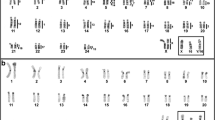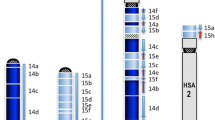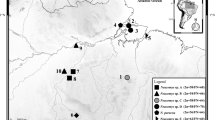Abstract
We performed multidirectional chromosome painting in a comparative cytogenetic study of the three howler monkey species Alouatta fusca, A. caraya and A. seniculus macconnelli (Atelinae, Platyrrhini) in order to reconstruct phylogenetic relationships within this genus. Comparative genome maps between these species were established by multicolor fluorescence in-situ hybridization (FISH) employing human, Saguinus oedipus and Lagothrix lagothricha chromosome-specific probes. The three species included in this study and previously analyzed howler monkey species were subjected to a phylogenetic analysis on the basis of a data matrix comprised of 98 discrete molecular cytogenetic characters. The results revealed that howler monkeys represent the genus with the most extensive karyotype diversity within Platyrrhini so far analyzed with high levels of intraspecific chromosomal variability. Two different multiple sex chromosome systems were identified. The phylogenetic analysis indicated that Alouatta is a monophyletic clade which can be derived from a proposed ancestral Atelinae karyotype of 2n=62 chromosomes by a chromosome fusion, a fission, a Y-autosomal translocation and a pericentric inversion. Following these suggestions, the genus Alouatta can be divided into two distinct species groups: the first includes A. caraya and A. belzebul, the second A. s. macconnelli, A. sara, A. s. arctoidea and A. fusca.
Similar content being viewed by others
References
Armada JLA, Barroso CML, Lima MMC, Muniz JAP, Seuánez HN (1987) Chromosome studies in Alouatta belzebul. Am J Primatol 13: 283-296.
Bonvicino CR, Lemos B, Seuánez HN (2001) Molecular phylogenetics of howler monkeys (Alouatta, Platyrrhini). A comparison with karyotypic data. Chromosoma 110: 241-246.
Consigliére S, Stanyon R, Koehler U, Agoramoorthy G, Wienberg J (1996) Chromosome painting defines genomic rearrangements between red howler monkey subspecies. Chromosome Res 4: 264-270.
Consigliére S, Stanyon R, Koehler U, Arnold N, Wienberg J (1998) In-situ hybridisation (FISH) maps chromsomal homologies between Alouatta belzebul (Platyrrhini, Cebidae) and other primates and reveals extensive interchromosomal rearrangements between howler monkey genomes. Am J Primatol 46: 119-133.
Ford SM (1986) Systematics of New World monkeys: In: Swindeler DR, Erwin J, eds. Comparative Primate Biology, Volume I: Systematics, Evolution and Anatomy. New York: Alan R. Liss, pp 73-135.
Garcia F, Nogués C, Garcia M, Egozcue J, Ponsà M (1999) Characterization of constitutive heterochromatin in Cebus apella (Cebidae, Primates) and Pan troglodytes (Hominidae, Primates): Comparison to human chromosomes. Am J Primatol. 49(3): 205-221.
Garcia F, Nogués C, Garcia M et al. (2000) Chromosomal homologies between human and Cebus apella (Primates) revealed by ZOO-FISH. Mamm Genome 11: 399-401.
Gregorin R (1996) Variaçäo Geográfica e Taxonomia das Espécies Brasileiras do gênero Alouatta Lacépède, 1799 (Primates, Atelidae). Masters Dissertation, Universidade de Säo Paulo, SP, Brazil.
Harada ML, Schneider H, Schneider MPC, Sampaio IM, Czelusniak J, Goodman M (1995) DNA evidence on the phylogenetic systematics of New World monkeys: Support for the sister-grouping of Cebus and Saimiri from two unlinked nuclear genes. Mol Phyl Evol 4: 331-349.
Hershkovitz P (1949) Mammals of the Northern Colombia. Preliminary report n. 4: Monkeys (primates with descriptions of four new forms. Folia Primatol 4: 381-395.
Hugot JP (1998) Phylogeny of Neotropical monkeys: the interplay of morphological, molecular and parasitological data. Mol Phylogenet Evol 9: 408-413.
Kay RF (1990) The phyletic relationships of extant and fossil Pithecinae (Platyrrhini). J Hum Evol 19: 175-208.
Koiffmann CP (1977) Variabilidade cromossômica na família Cebidae (Platyrrhini, Primates). Doctoral thesis, Instituto de Biologia, USP, Säo Paulo.
Lima MMC, Seuánez HN (1989) Cytogenetic characterization of Alouatta belzebul with atypical pelage coloration. Folia Primatol 52: 97-101.
Lima MMC, Seuánez HN (1991) Chromosome studies in the red howler monkey, Alouatta seniculus stramineus (Platyrrhini, Primates): description of an X1X2Y1Y2/X1X1X2X2 sex chromosome system and karyological comparisons with other subspecies. Cytogenet Cell Genet 57: 151-156.
Lima MM, Sampaio MIC, Schneider MPC, Scheffrahn W, Schneider H, Salzano FM (1990) Chromosome and protein variation in red howler monkeys. Rev Brasil Genet 13 (04): 789-802.
Ma NSF, Jones TC, Thorington RW, Miller A, Morgan L (1975) Y-autosome translocation in the howler monkeys, Alouatta palliata. J Med Primatol 4: 299-307.
Meireles CM, Czelusniak J, Schneider MPC et al. (1999a) Molecular phylogeny of Ateline New World monkeys (Platyrrhini, Atelinae) based on γ-globin pseudogene sequences: evidence that Brachyteles is the sister group of Lagothrix. Mol Phyl Evol 12:10-30.
Meireles CM, Czelusniak J, Ferrari SF, Schneider MPC, Goodman M (1999b) Phylogenetic relationships among Brazilian howler monkeys, genus Alouatta (Platyrrhini, Atelidae), based on γ1-globin pseudogene sequences. Genet Mol Biol 22: 337-344.
Minezawa M, Harada M, Jordan OC, Borda CJV (1985) Cytogenetics of Bolivian endemic red howler monkeys (Alouatta seniculus sara): Accessory chromosome and Y-autosome translocation related numerical variations. Kyoto Univ Overseas Res Rep New World Monkeys 5: 7-16.
Mittermeier RA, Coimbra-Filho AF (1981) Systematics: Species and subspecies. In: Coimbra-Filho AF, Mittermeier RA, eds. Ecology and Behaviour of Neotropical Primates. Rio de Janeiro, Academia Brasileira de Ciencias.
Morescalchi MA, Schempp W, Wienberg J, Stanyon R (1997) Chromosome painting in the New World monkey, Ateles geoffroyi, the black-handed spider monkey. Chromosome Res 5: 527-536.
Mudry M, Ponsa M, Borell A, Egozcue J, Garcia M (1994) Prometaphase chromosomes of the howler monkey (Alouatta caraya): G, C, NOR and restriction enzyme (Res) banding. Am J Primatol 33: 121-134.
Mudry MD, Rahn M, Gorostiaga M, Hick A, Merani MS, Solari AJ (1998) Revised karyotype of Alouatta caraya (Primates, Platyrrhini) and A. seniculus macconnelli on synatonemal complex and banding analysis. Hereditas 128(1): 9-16.
Müller S, Stanyon R, O'Brien PC, Ferguson-Smith MA, Plesker R, Wienberg J (1999) Defining the ancestral karyotype for all primates by multidirectional chromosome painting between tree shrews, lemurs and humans. Chromosoma 108: 393-400.
Müller S, Neusser M, Stanyon R, Wienberg J (2001) Molecular cytogenetic characterization of EBV producing cell line B95-8 (S. oedipus, Platyrrhini) by flow cytometry and multicolour cross species chromosome painting. Chromosome Res 9: 689-693.
Neusser M, Wienberg J, Stanyon, R, Müller S (2001) Molecular cytotaxonomy of Platyrrhini - comparative analysis of five species by multicolour reciprocal chromosome painting gives evidence for a classification of Callimico goeldii with Callitrichidae. Cytogenet Cell Genet 94: 206-215.
de Oliveira EHC (1996) Estudos citogenéticos e evolutivos nas espécies brasileiras e argentinas do g-enero Alouatta (Atelidae, Platyrrhini). Masters Thesis. Universidade Federal do Paraná, Curitiba, PR, Brasil.
de Oliveira EHC, Sbalqueiro IJ, Lima MMC, Pissinati A (1998) The karyotype of Alouatta fusca from Rio de Janeiro, Brazil: Evidence of a Y-autosome translocation. Genet Mol Biol 21(3): 361-364.
de Oliveira, EHC, Suemitsu E, da Silva AF, Sbalqueiro IJ (2000) Geographical variation of chromosomal number in Alouatta fusca clamitans (Primates, Atelidae). Caryologia 53: 163-168.
Rahn MI, Mudry M, Merani MS, Solari AJ (1996) Meiotic behavior of the X1X2Y1Y2 quadrivalent of the primate Alouatta caraya.Chromosome Res 4: 350-356.
Richard F, Lombard M, Dutrillaux B (1996) ZOO-FISH suggests a complete homology between human and Capuchin monkey (Platyrrhini) euchromatin. Genomics 36: 417-423.
Rokas A, Holland WH (2000) Rare genomic changes as a tool for phylogenetics. Trends Ecol Evol 15: 454-459.
Rosenberger AL (1981) Systematics: the higher taxa. In: Coimbra-Filho AF, Mittermeier R, eds. Ecology and Behavior of Neotropical Primates, Vol. I. Rio de Janeiro: Acad Brasileira de Ciencias, pp 9-27.
Schneider H, Schneider MPC, Sampaio MIC, Harada ML, Stanhope M, Goodman M (1993) Molecular phylogeny of the New World monkeys (Platyrrhini, Primates). Mol Phylogenet Evol 2: 225-242.
Schneider H, Sampaio I, Harada ML et al. (1996) Molecular phylogeny of the New World monkeys (Platyrrhini, Primates) based on two unlinked nuclear genes: IRBP intron 1 and e-globin sequences. AmJ Phys Anthropol 100: 153-179.
Schneider H, Canavez FC, Sampaio I, Moreira MA, Tagliaro CH, Seuánez HN (2001) Can molecular data place each neotropical monkey in its own branch? Chromosoma 109: 515-523.
Sherlock JK, Griffn DK, Delhanty JDA, Parrington JM (1996). Homologies between human and Marmosett (Callitrix jacchus) chromosomes revealed by comparative chromosome painting. Genomics 33: 214-219.
Stanyon R, Tofanelli S, Morescalchi MA, Agoramoorthy G, Ryder OA, Wienberg J (1995) Cytogenetic analysis shows extensive genomic rearrangements between red howler (Alouatta seniculus, Linnaeus) subspecies. Am J Primatol 35: 171-183.
Stanyon R, Consigliére S, Müller S, Morescalchi A, Neusser M, Wienberg J (2000) Fluorescence in situ hybridization (FISH) maps chromosomal homologies between the dusky titi and squirrel monkey. Am J Primatol 50: 95-107.
Stanyon R, Consigliére S, Bigoni F, Ferguson-Smith M, O'Brien PC, Wienberg J (2001) Reciprocal chromosome painting between a New World primate, the woolly monkey, and humans. Chromosome Res 9: 97-106.
Swofford D (1998) PAUP*. Phylogenetic Analysis Using Parsimony (*and Other Methods). Version 4. Sinauer Associates, Sunderland, Massachusetts.
Telenius H, Pelmear AHP, Tunnacliffe A et al. (1992) Cytogenetic analysis by chromosome painting using DOP-PCR amplified flow-sorted chromosomes. Genes Chromosomes Cancer 4: 257-263.
Yunis EJ, Torres de Caballero OM, Ramirez C, Ramirez ZE (1976) Chromosomal variation in the primate Alouatta seniculus seniculus. Folia Primatol 25: 215-224.
Author information
Authors and Affiliations
Rights and permissions
About this article
Cite this article
de Oliveira, E.H.C., Neusser, M., Figueiredo, W.B. et al. The phylogeny of howler monkeys (Alouatta, Platyrrhini): Reconstruction by multicolor cross-species chromosome painting. Chromosome Res 10, 669–683 (2002). https://doi.org/10.1023/A:1021520529952
Issue Date:
DOI: https://doi.org/10.1023/A:1021520529952




